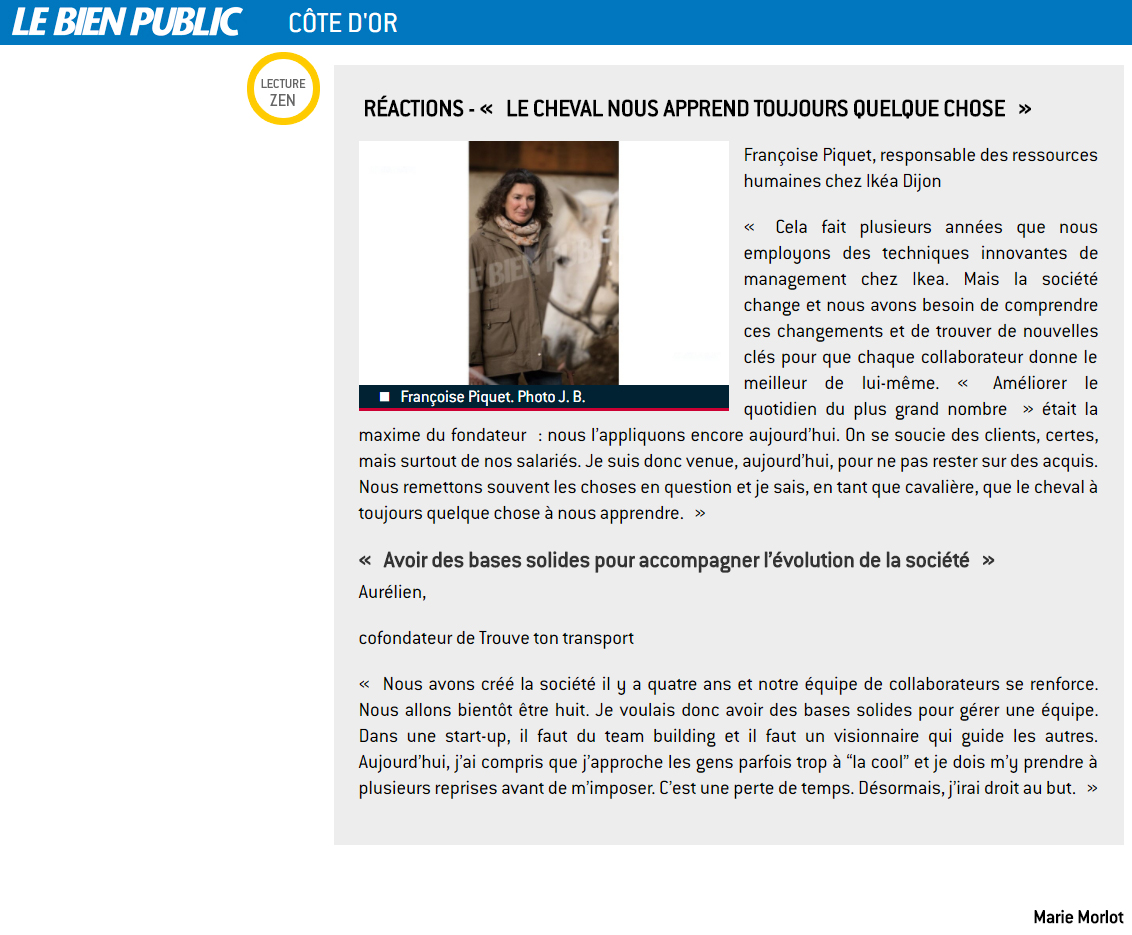Equicoaching discovery morning with Le Bien Public
Thursday, 8:30 a.m., at the Académie Equestre de Bonvaux in Plombières-lès-Dijon: six managers have swapped suits for a pair of boots and a crop. For one morning, they’ll be taking part in an equicoaching session. And so will we. The first step is a « return to calm ». Zen breathing and mental projections do the trick. Then it’s off to the manège for the first exercise.
« Setting limits »
Jessica, the coach, is about ten meters in front of us. She moves forward to join us, crossing several invisible boundaries: our public zone, our connection zone and then our intimacy zone. It’s up to us, whipping a riding crop towards the ground, to stop her in her tracks so that she doesn’t get so close as to make us uncomfortable. « If you don’t make it clear to me with the whip that I mustn’t go any further, the message will be blurred and I’ll feel I have the right to approach again, » explains Jessica. This simple game provides us with our first key: in a company, it’s always the person being solicited who must set his or her own limit. « No-one else can guess for you where it is », she repeats. Our « manager-riders » nod in agreement when reminded of this simple social rule.
Next to enter the ring is Limande, a beautiful white mare who is totally unused to the following exercise: « You’re going to have to convince her to follow you for a few steps, » explains Sophie, the second coach. Nothing complex. There’s just one detail: you’re not allowed to talk to or touch the animal. « Here, we work on non-verbal communication. Horses are all about feeling. If you think he won’t come to you, it’s a failure », the two » teachers » assure us.
We approach the horse, who prefers to sniff a cone. « Our guide advises us: « Be patient and try to capture his attention visually to enter his connection zone. Our eyes intensify, our bodies tense up and our feet anchor themselves in the ground: Limande senses our energy and knows that we’re now the ones calling the shots. Her ears perk up, her head turns. Our eyes are locked in hers. We move a little closer. « See ? She’s starting to chew, which means she’s relaxing, » says Sophie. Limande is now confident and seems to hear our silent message. All she’s waiting for now is to leave with us. Absolutely convinced that she’s going to follow us, we take one step, then two. Behind us, the animal’s hooves clatter to the ground. She’s moving !
« Don’t doubt, don’t stop. Keep walking », say the coaches. One ride later, still without touching her halter and without a word, Limande is brought to the center of the workshop, before being brought to a sudden halt. Just because we « firmly wish it ».
Make yourself understood without giving orders.
« You were convinced it would work. So, she trusted you and went along with it, » says Jessica, who has demonstrated that it is possible to « convince and unite without giving orders ». Now, all our managers have to do is apply the technique with their teams. Minus the whip, of course.
She trusted you because you believed it would work. Jessica, equicoach.
A word from the manager :
« During an equicoaching session, you don’t sit in front of a powerpoint. You’re working with a horse on emotional intelligence and non-verbal language, » explains Thierry Cesareo, managing director of Azimut Partners, a consulting firm and training organization that has recently begun offering this astonishing training to its customers. The aim is to help leaders, team leaders, human resources managers and bosses to better understand interactions with their collaborators, enabling them to pass on clearer messages and limit conflict situations.
« Evolved man concentrates only on the head and speech. We’ve forgotten the body, the heat it gives off and our physiological reactions. We’ve also forgotten that an emotion generates a physical action on our part, no matter how small. The horse, on the other hand, picks up these non-verbal signals in the moment: he observes, analyzes our gestures and decodes our behavior, reacting accordingly. If you approach too quickly, he’ll back off. If you’re not sure of yourself, he won’t follow. If we can communicate with him through our emotions and intentions, we’ll gain his trust », continues our interviewer. And having a horse’s trust means being able to take him wherever you want. The parallel with managing a team of employees is obvious.
Thierry CESAREO
Thanks to Aurélien CELESTRANO and Jérémy TUZZA from Trouve ton Transport for their participation.




